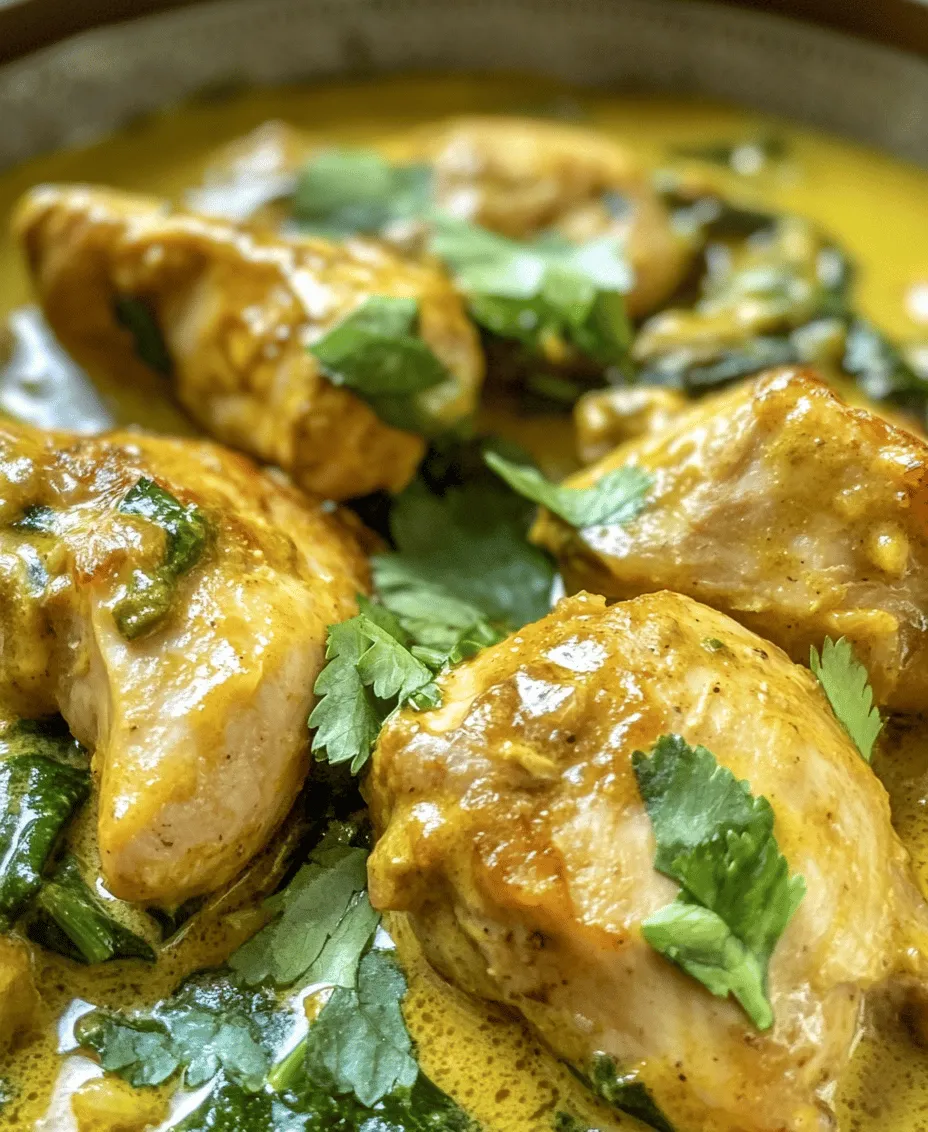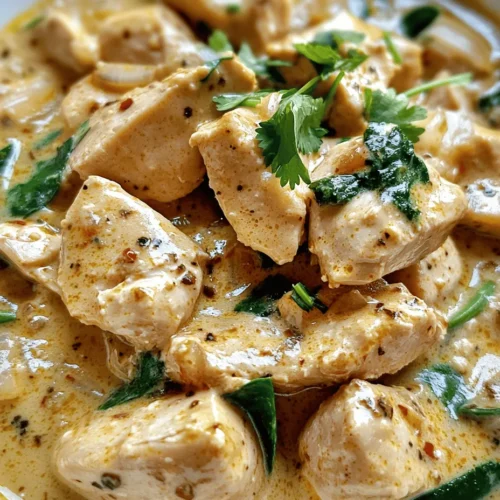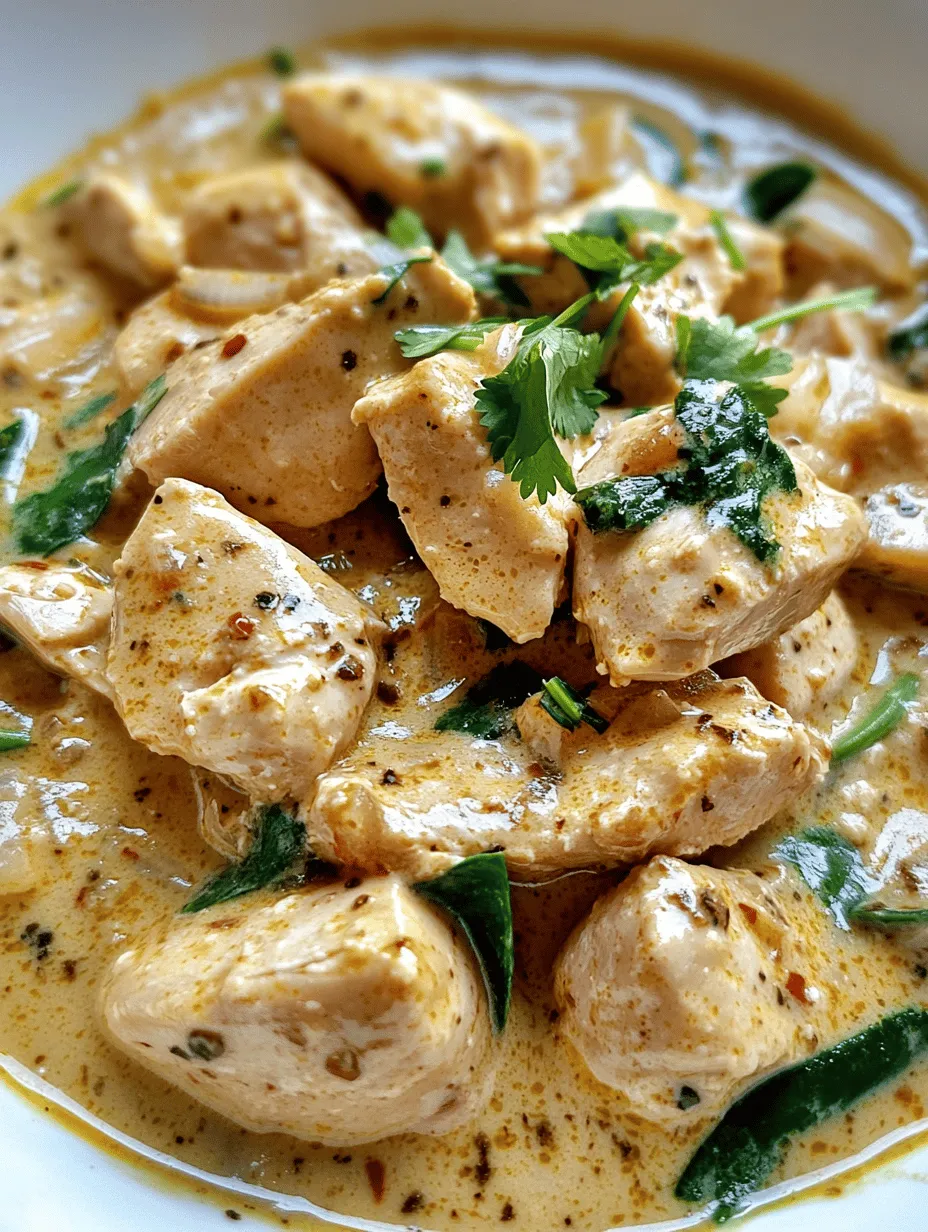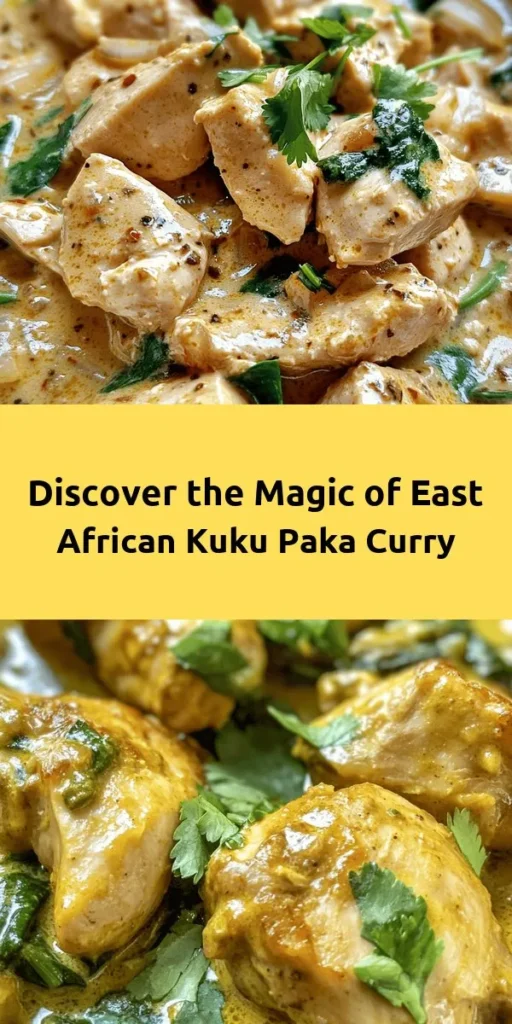Introduction
Kuku Paka is a traditional dish that embodies the vibrant culinary heritage of East Africa, particularly cherished in coastal regions such as Kenya and Tanzania. This tantalizing chicken curry is not only a staple in local cuisine but also a symbol of cultural identity, reflecting the diverse influences that shape East African food. Kuku Paka stands out for its unique blend of flavors, which combines tender chicken, rich coconut milk, and an array of aromatic spices, creating a dish that is both comforting and exotic.
The significance of Kuku Paka extends beyond mere nourishment; it serves as a centerpiece for social gatherings and family celebrations. Whether enjoyed during festive occasions or casual family dinners, this dish brings people together, fostering a sense of community and connection. The melding of diverse cultural influences—African, Arab, and Indian—creates a flavor profile that is as rich as the region’s history.
What makes Kuku Paka truly special is its ability to transform simple ingredients into a sensational culinary experience. The use of coconut milk provides a creamy texture that balances the spices, while the addition of fresh herbs and chilies adds depth and brightness to the dish. This recipe not only satisfies the palate but also nourishes the soul, making it a beloved choice for many.
Understanding Kuku Paka
At its core, Kuku Paka is a coconut chicken curry that showcases the bountiful flavors of East Africa. The dish’s name, “Kuku,” translates to “chicken” in Swahili, while “Paka” means “to smear” or “to spread,” referring to the luscious coconut sauce that envelops the chicken. The origins of Kuku Paka can be traced back to the coastal regions of East Africa, where the abundance of coconuts and spices inspired countless culinary creations.
Kuku Paka is celebrated in various forms across different East African countries, each region adding its unique twist to the recipe. In Kenya, for example, the dish is often served with rice or ugali, whereas in Tanzania, it might be accompanied by chapati or plantains. These regional variations highlight the adaptability of Kuku Paka, allowing it to resonate with local palates while maintaining its essential characteristics.
The dish plays a pivotal role in social and family gatherings, often serving as a main course during celebrations, weddings, and communal feasts. Its inviting aroma and vibrant colors make Kuku Paka a feast for the senses, symbolizing hospitality and warmth, inherent to East African culture. Whether enjoyed in a bustling family setting or during a quiet dinner, Kuku Paka brings people closer, creating lasting memories.
Ingredients Breakdown
To create the perfect Kuku Paka, it is essential to understand the main ingredients that contribute to its unique flavor profile. Each component plays a crucial role in crafting this delicious dish:
1. Chicken: The star ingredient, chicken provides a tender and juicy base for the curry. Typically, bone-in pieces are preferred for their rich flavor and moisture retention during cooking.
2. Coconut Milk: This creamy ingredient is the heart of Kuku Paka, lending a luscious texture and a hint of sweetness that balances the spices. Coconut milk is not only delicious but also offers health benefits, including healthy fats that promote heart health.
3. Onions: Sautéed onions add depth of flavor and sweetness to the sauce, acting as the aromatic foundation for the dish.
4. Garlic and Ginger: These aromatic ingredients infuse the dish with warmth and complexity. They are essential for building the flavor base of Kuku Paka.
5. Tomatoes: Fresh or canned tomatoes add acidity and brightness, enhancing the overall taste of the curry. Their natural sweetness also complements the coconut milk.
6. Spices: A blend of spices such as cumin, coriander, turmeric, and chili powder is crucial for achieving the signature flavor of Kuku Paka. Each spice contributes its distinct aroma and taste, creating a harmonious blend that elevates the dish.
7. Fresh Herbs: Cilantro or parsley is often used as a garnish, adding freshness and a pop of color to the final presentation.
8. Optional Ingredients: Some recipes incorporate vegetables like spinach or bell peppers, which add nutritional value and vibrant colors to the dish.
Understanding the significance of each ingredient helps to appreciate the complexity and richness of Kuku Paka. Beyond flavor, many of these ingredients also offer health benefits. For instance, coconut milk is rich in vitamins and minerals, while spices like turmeric are known for their anti-inflammatory properties. This makes Kuku Paka not only a delightful dish but also a nourishing choice for any meal.
Marinating the Chicken: The Key to Flavor
One of the most critical steps in preparing Kuku Paka is marinating the chicken. This process enhances the flavor and tenderness of the meat, ensuring that each bite is infused with the aromatic spices and coconut essence. Marination allows the flavors to penetrate deeply into the chicken, creating a succulent and savory result.
Importance of Marination
Marinating the chicken serves multiple purposes:
– Flavor Absorption: The spices and seasonings used in the marinade penetrate the meat, enhancing its overall taste.
– Tenderization: The acid in the marinade, often derived from ingredients like yogurt or lemon juice, helps to break down the proteins in the chicken, resulting in a more tender texture.
– Moisture Retention: A well-marinated chicken retains moisture during cooking, preventing it from drying out and ensuring a juicy final product.
Detailed Explanation of the Marination Process
To marinate the chicken effectively, follow these steps:
1. Prepare the Marinade: In a bowl, combine your chosen spices, minced garlic, grated ginger, and a splash of coconut milk to create a flavorful paste. You can also add a pinch of salt and pepper to taste.
2. Coat the Chicken: Place the chicken pieces in the bowl and thoroughly coat them with the marinade. Ensure that each piece is well-covered for maximum flavor absorption.
3. Marinating Time: For optimal results, allow the chicken to marinate for at least 1 hour. However, if you have the time, marinating overnight in the refrigerator is ideal. This extended period allows the flavors to penetrate deeply into the meat.
4. Store Properly: If marinating overnight, ensure the chicken is covered to prevent cross-contamination and to keep it fresh.
By taking the time to marinate the chicken, you set the stage for a flavorful and tender Kuku Paka that will impress your family and friends.
In the next part of this article, we will explore the process of creating the perfect sauce for Kuku Paka, ensuring that each element of this dish comes together harmoniously to create a culinary masterpiece. Stay tuned as we dive deeper into the flavors and techniques that make Kuku Paka an unforgettable experience!

Step-by-Step Guide to Preparing the Base Sauce
To create the rich and flavorful base sauce for Kuku Paka, you must start with a blend of essential ingredients that encapsulate the essence of East African cooking. Begin by heating a generous amount of oil in a large pan over medium heat. Once the oil is hot, add finely chopped onions. Sauté the onions until they are golden brown and translucent, which usually takes about 5 to 7 minutes. This step is crucial as it develops the foundational flavor of the sauce.
Next, introduce minced garlic and ginger into the pan. Sauté them for an additional minute until they become fragrant, ensuring they do not burn. Following this, incorporate chopped tomatoes and cook until they break down and soften. This will create a rich tomato base that complements the spices beautifully.
Now, it’s time to add the spices. A blend of ground coriander, cumin, turmeric, and a pinch of chili powder will elevate the flavor profile. Stir the spices into the mixture and allow them to toast for a minute, releasing their natural oils and enhancing their flavors. Finally, pour in coconut milk, stirring well to combine all the ingredients. Allow the mixture to simmer for about 10 to 15 minutes; this will thicken the sauce and meld the flavors together perfectly.
The Significance of Sautéing Onions to Achieve the Right Flavor and Texture
Sautéing onions is more than just a preparatory step; it is a fundamental technique that sets the stage for a deeply flavored dish. Onions, when cooked slowly, caramelize, developing sweetness and depth that enhance the overall taste of Kuku Paka. The natural sugars in onions caramelize when exposed to heat, resulting in that golden brown color and a rich, sweet flavor that balances the dish’s spices.
In Kuku Paka, this process is critical as it harmonizes with the heat of the chili powder and the earthiness of cumin and coriander. Not only do sautéed onions add flavor, but they also contribute to the texture of the sauce, creating a luscious mouthfeel that coats the chicken beautifully.
How to Balance Spices for an Authentic Taste
The key to an authentic Kuku Paka lies in the balance of spices. Each spice plays a unique role, and together they create a symphony of flavors that reflect the culinary heritage of East Africa. Start with a base of coriander and cumin, which provide warmth and earthiness. Turmeric adds a beautiful golden color and a subtle bitterness, while chili powder introduces heat that can be adjusted to your taste.
To ensure a balanced flavor, it’s advisable to start with smaller quantities and gradually adjust according to your preference. Taste as you go; this is essential in developing a dish that resonates with your palate. Keep in mind that spices can intensify as they cook, so be cautious not to overpower the dish. The goal is to create a harmonious blend that enhances the chicken and the overall sauce.
Cooking the Chicken: Techniques and Tips
When it comes to cooking the chicken for Kuku Paka, achieving juicy and flavorful meat is paramount. Begin by marinating the chicken pieces in a mixture of salt, pepper, and a bit of lemon juice. This not only seasons the meat but also tenderizes it. Allow it to marinate for at least 30 minutes, or even overnight if time permits, to allow the flavors to penetrate.
Once marinated, heat a bit of oil in the same pan used for the sauce, and sear the chicken pieces over medium-high heat. This step is crucial as it locks in moisture and flavor. Cook the chicken until it is browned on all sides but not fully cooked through—this should take about 10 minutes. The browning adds depth to the flavor, enhancing the overall dish.
After searing, return the chicken to the sauce, ensuring it is well-coated. This is where coconut milk plays a significant role. It not only adds creaminess but also helps to keep the chicken moist during cooking. Allow the chicken to simmer gently in the sauce for 20 to 30 minutes, or until it reaches an internal temperature of 165°F (75°C). The coconut milk will thicken and envelop the chicken in a luscious sauce that is characteristic of Kuku Paka.
Discussing the Role of Coconut Milk in the Cooking Process
Coconut milk is a star ingredient in Kuku Paka, bringing richness and a subtle sweetness that balances the spices. Its creamy texture enhances the sauce, making it luxurious and comforting. Coconut milk also acts as a natural tenderizer for the chicken, ensuring that it remains juicy and flavorful throughout the cooking process.
When adding coconut milk, consider using full-fat coconut milk for the best flavor and consistency. If you prefer a lighter version, you can opt for light coconut milk, but be aware that it may alter the richness of the dish. The coconut milk should be added after the spices have cooked, allowing it to integrate fully into the sauce without curdling.
Adjusting Spice Levels According to Personal Preference
One of the wonderful aspects of Kuku Paka is its versatility in accommodating different spice levels. If you enjoy a milder dish, you can reduce the amount of chili powder and opt for a gentle pepper, such as paprika, instead. Conversely, if you prefer a spicier kick, feel free to increase the chili powder or even add fresh chopped chilies for an extra punch.
Always taste the sauce before serving. You can add more salt, pepper, or spices as needed to achieve your desired flavor profile. The beauty of Kuku Paka lies in its adaptability, allowing you to create a version that is uniquely yours.
Finishing Touches and Presentation
Achieving the right consistency for the Kuku Paka sauce is essential for an appealing presentation. The sauce should be thick enough to coat the back of a spoon but not so thick that it loses its silky texture. If the sauce is too thick, you can add a splash of water or more coconut milk to loosen it up. Conversely, if it’s too thin, allow it to simmer uncovered for a few more minutes to reduce.
Garnishing with fresh cilantro not only enhances the visual appeal but also adds a burst of freshness that complements the richness of the dish. Simply chop some fresh cilantro and sprinkle it over the Kuku Paka just before serving. This final touch elevates the dish and adds a pop of color that makes it inviting.
Serving Suggestions: Pairing Kuku Paka with Rice, Chapati, or Steamed Vegetables
Kuku Paka is incredibly versatile when it comes to serving options. Traditionally, it is enjoyed with steamed rice, which soaks up the delicious sauce beautifully. You can also serve it with chapati, a type of flatbread that is perfect for scooping up the rich sauce. Another delightful option is to pair Kuku Paka with a side of steamed vegetables, which adds a healthy crunch and balances the meal.
For a complete culinary experience, consider serving the dish alongside a refreshing cucumber salad or a tangy tomato salsa. These sides will provide a contrast to the richness of Kuku Paka, creating a well-rounded meal that is satisfying and delightful.
Cultural Significance of Kuku Paka
Kuku Paka is more than just a dish; it is a representation of East African culture, embodying the region’s rich culinary heritage. Originating from coastal areas of Kenya and Tanzania, Kuku Paka reflects the influence of Indian and Arab cuisines, showcasing the historical ties and cultural exchanges that have shaped the region’s food.
In many East African households, Kuku Paka is a dish prepared for gatherings and celebrations, symbolizing togetherness and hospitality. Families often have their own variations and stories associated with the dish, passed down through generations. These personal anecdotes add a layer of depth and nostalgia to the dish, making it a cherished part of family traditions.
Kuku Paka is also a reflection of the culinary diversity found within East Africa. Ingredients such as coconut and spices highlight the region’s tropical climate and abundant resources, showcasing local flavors and cooking techniques. Each bite tells a story of the land, its people, and their culinary journey.
Conclusion
In summary, Kuku Paka is a delightful dish that combines tender chicken simmered in a rich coconut sauce, reflecting the vibrant culinary traditions of East Africa. The key steps in preparing this dish—from sautéing onions to balancing spices and ensuring juicy chicken—are essential for creating an authentic flavor experience.
As you explore Kuku Paka, consider it a gateway into a broader culinary journey, inviting you to discover the diverse flavors and traditions of East African cooking. Cooking is a joyous act that brings people together, and sharing traditional recipes like Kuku Paka with family and friends allows you to create lasting memories.
Encourage yourself to embrace the process of cooking, experimenting with flavors, and infusing your personal touch into this wonderful dish. Kuku Paka awaits you, ready to be enjoyed and celebrated as part of your culinary adventures.



